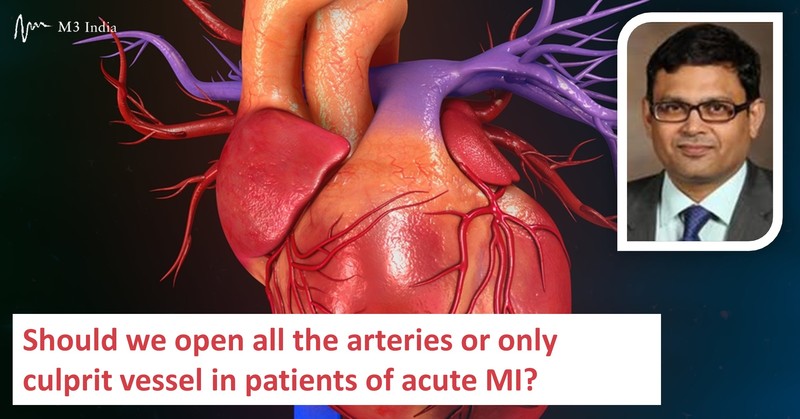Should we open all the arteries or only culprit vessel in patients of acute MI?: Dr. Mishra answers
M3 India Newsdesk Jan 16, 2020
Prof. Dr. Sundeep Mishra reviews two trials, COMPLETE and CULPRIT-SHOCK which sought to investigate whether complete revascularisation was beneficial in patients with STEMI and multivessel disease, and the efficacy of MVD PCI in patients with cardiogenic shock.

Primary percutaneous coronary intervention (PCI) has become the first-line management in ST-elevated myocardial infarction (STEMI). The advantages of primary PCI over thrombolysis or medical management are well established as a result of numerous trials. But, these trials are focused mainly on single vessel disease (SVD) and revascularisation of infarct related artery (IRA). Nearly half of all patients presenting with STEMI have multivessel disease (MVD).
In here, the treatment of non-culprit lesions- whether to revascularise interventionally or use only guideline-directed medical therapy (GDMT) has been a matter of debate. In many cases these plaques represent stable coronary artery disease and warrant only medical therapy.
On the other hand, these non-IRAs continue to represent zones of ongoing ischaemia (even if stable) and many of them can easily be tackled along with the primary revascularisation of IRA with minimal additional risks.
In the past, guidelines from the American College of Cardiology/American Heart Association (ACC/AHA), European Society of Cardiology (ESC) have given Class IIB recommendations for revascularisation of non-culprit vessels after primary PCI. Previously, many intermediate-sized trials had shown benefit of complete revascularisation, albeit, stage one especially in terms of ischaemia-driven revascularisation, but none of these trials had the power to evaluate hard outcomes like cardiovascular death or myocardial infarction and thus the guideline recommendations.
What about large, hemodynamically important vessel with a type A lesion?
PCI of this non-IRA vessel could help in resolving the hibernating/stunned myocardium and also increase the blood flow to watershed areas of infarction thus improving myocardial salvage and thereby provide complete revascularisation.
Approximately 5 to 10% of cases of STEMI are complicated by cardiogenic shock. The issue of revascularisation of non-IRA could be completely different. These patients (with cardiogenic shock) are sicker and frequently have low aortic pressure and high left ventricular end-diastolic pressure. In this context PCI of non-IRA (along with IRA) may improve myocardial perfusion and thus myocardial function, systemic circulation, and aid in recovery from cardiogenic shock.
On the other hand, MVD PCI may contribute to increased procedural time, more use of contrast, increased thrombogenicity and even possibly reduced bio-availability of anti-platelet agents (because of reduced enteric absorption) which may contribute to higher risk of stent thrombosis (maybe all stents together) in the future. Historically, guidelines advocated the use of MVD PCI in this situation not based on data (which was deficient) but primarily based on expert opinion. We will discuss 2 recent trials which have addressed this complex issue.
COMPLETE Trial
Recently, the COMPLETE trial published in the New England Journal of Medicine sought to investigate whether complete revascularisation strategy was beneficial among patients with STEMI and multivessel coronary disease. The trial randomised 4041 patients presenting within 72 hours after successful primary PCI to the culprit lesion to either complete revascularisation (undergoing staged PCI during the index hospitalisation or after hospital discharge within 45 days) versus culprit-lesion-only PCI group.
This trial revealed that a strategy of complete revascularisation resulted in 26% lower risk of composite of death from cardiovascular cause or new myocardial infarction at a median follow up of 3 years compared to culprit vessel only PCI in patients of STEMI and multivessel disease.
The number needed to treat to prevent cardiovascular death or myocardial infarction from occurring in 1 patient is 37, and the number needed to treat to prevent cardiovascular death, myocardial infarction, or ischemia-driven revascularisation from occurring in 1 patient is 13.
Thus, there seems to be a huge benefit of complete revascularisation even in patients with STEMI, like other CAD groups, but this revascularisation in non-IRA can be staged.
CULPRIT-SHOCK Trial
Data from the randomised, large-scale (n = 706) CULPRIT-SHOCK (Culprit Lesion Only PCI Versus Multivessel PCI in Cardiogenic Shock) trial also published in the New England Journal of Medicine created a “shockwave” challenging the fervently held opinion regarding the benefit of MVD PCI in STEMI patients presenting with cardiogenic shock.
This trial had randomised in a 1:1 ratio patient to either culprit only PCI (with the option of staged revascularisation of non-IRA lesion/s) or immediate MVD. The trial found that in patients with STEMI presenting with cardiogenic shock, the risk of death or renal-replacement therapy at 30 days was lower with IRA-only PCI versus than with immediate MVD PCI.
Furthermore, the composite of death or recurrent infarction was 13% lower in IRA-only strategy. However, expectedly, rate of repeat revascularisation was commoner in IRA-only group as also was re-hospitalisation for heart failure.
Overall, with the publication of this trial, there has been a change in medical practice away from total revascularization to culprit vessel-only revascularisation in patients with cardiogenic shock with a possibility of staged revascularisation of non-IRA later on.
Disclaimer- The views and opinions expressed in this article are those of the author's and do not necessarily reflect the official policy or position of M3 India.
The author, Dr. Sundeep Mishra is a Professor of Cardiology.
-
Exclusive Write-ups & Webinars by KOLs
-
Daily Quiz by specialty
-
Paid Market Research Surveys
-
Case discussions, News & Journals' summaries